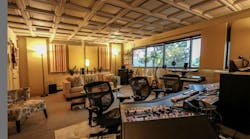The 20-year-old mineral fiber ceiling panels at OC Recording Company weren’t just old—they were falling apart and filling the air with dust and fibers. Asaf Fulks, the artist, producer, engineer and educator who owns the Santa Ana, CA-based studio, was fed up.
“My main concern was air quality in my studio,” Fulks explains. “It felt really stuffy, and it was always dusty and flaky from the ceiling. It worked pretty well for sound, but the air quality and the look were something else.”
Fulks decided to investigate on his own. Online, he discovered Ceilume. The manufacturer’s thermoformed rigid vinyl ceiling panels wouldn’t release particles all over Fulks’ equipment like the traditional mineral fiber panels. Fulks opted for the deeply molded Westminster model to create height in the ceiling. He also replaced the fiberglass insulation with Soniguard itch-free batt insulation, which is made from polyester fibers similar to what’s used in upholstery.
Below, interiors+sources chats with Fulks about replacing the ceiling in his studio.
interiors+sources: What criteria were you looking to meet when you were looking for a new ceiling? How did the Ceilume product you picked meet those demands?
Asaf Fulks: I want to be able to breathe, but as a recording studio, it’s got to sound right as well. The Noise Reduction Coefficient was important. They ended up sounding really good—they don’t provide as much absorption as the other ceiling did, but the sound kind of bounces through, hits off the top ceiling and goes back out.
They’ve actually helped liven up the room a little bit. I’m happy with it in terms of sound and air quality. It’s much less stuffy, and I love the look of it. I’m not really handy and I don’t build things, but I was able to take out the other ceiling and put this all in by myself in one day—they just popped right in.
(Pictured: Ceilume Westminster 2x2 Latte: Fulks opted for the Westminster design in Latte. The color goes with some of the existing finishes and artwork in the space, and Westminster’s deeply molded design creates height in the ceiling. Credit: Ceilume)
Interiors+sources: Did you consider other materials besides the panels you eventually chose? What made you finally go with Ceilume and why did you pick the Westminster panels?
Fulks: I did a lot of research, but I definitely wanted this type of design. I eventually went with a beveled design, which is beneficial for the sound as well. Any time you have something flat, it’s not good for the sound. This design makes the ceiling a little bit taller, and the angle helps reflect the sound in different directions, which is good acoustically.
[Related: Luxxbox Founder Reveals the Inspiration Behind Brix, a New Modular Acoustic System]
Credit: OC Recording Company
interiors+sources: Did you run into any challenges with the panels? If so, how did you solve them?
Fulks: I can’t say I have. I’ve had to go into the ceiling a few times for maintenance and they pop right in and out. They’re super durable—I haven’t had to replace them. They still look like the day I bought them in 2018. Also, I was able to go into the ceiling and vacuum up there, and I could vacuum on top of the polyester insulation—I wouldn’t dream of doing that on fiberglass.
Fulks installed the 360-square-foot ceiling himself in under a day. Most of the panels popped into the grid easily. The tiles are GreenGuard Gold certified for indoor air quality, mold- and allergen-free and waterproof.
interiors+sources: How has the new ceiling performed since you installed it?
Fulks: It’s been amazing. The only drawback is that it’s not great for isolation where you’re trying to keep the sound in one room, but otherwise the sound and acoustics within the room sound great—probably better than before. It has more of a live feel. They look amazing, and as for the air quality, I have noticed a lot less dust on my desk. I’m a happy customer two years later.
Read next: CertainTeed’s Ceiling Tiles Help Preserve Original Look of a Landmark NYC Building

